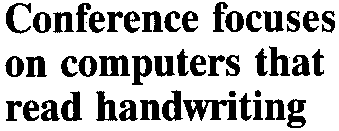



The latest approach to pen based computing interactive systems off-line reading of handwriting and the problems of teaching computers to read, alphabets that have thousands of characters(Such as Chinese) will be the focus of the third International Workshop on Frontiers in Handwriting Recognition, which will be held Tuesday through Thursday at the University of Buffalo.
Ellen Goldbaum of Ub's News Bureau said it is the first time the workshop on getting computers to understand the infinite variety of loops and curlicues that make up human handwriting is being held in the United States.
She said the conference is being hosted by the U.S. Postal Service supported Center of excellence for Document Analysis and Recognition(CEDAR) at UB. Designated by the Postal Service in 1990 to develop computer vision technologies to help speed the processing of mail, CEDAR is recognized internationally for its work in the development of off-line handwriting recognition technology.
"The main shortcoming of pen based computing lies in handwriting recognition," said Sargur Srihari, UB professor of computer science and director of CEDAR. "This conference brings together the key researchers from industry and academic institutions from all over the world."
Keynote speakers at the conference will be Jean Claude Simon, president of the Paris-based A2IA (Artificial Intelligence and Image Analysis) and a theoretician who attempts to bridge the gap between handwriting-recognition theory and practice, and Ray Morgan, manager of advanced research at the U.S. Postal Service, according to Ms. Goldbaum.
Among the participants will be representatives of industrial and academic institutions, including AT&T Bell Labs, IBM, NEC Corp., Toshiba, Goldstar Central Research Laboratory, Paragraph International, Calera Recognition Systems, Daimler-benz Research Center, the University of Sussex, Ecole Polytechnique -- Montreal, George Washington University, the University of Toronto and the Japanese Ministry of Posts and Telecommunication.
Ms Goldbaum said various handwriting-recognition systems will be demonstrated at the conference, including one developed by George Washington University researchers that teaches the Hebrew alphabet by acting like a personal tutor. It follows the strokes a student makes on a tablet and suggests ways to improve the strokes. It superimposes the correct letter over the student's.
Another system to be featured was developed at Taiwan's Industrial Technology Research Institute to recognize Chinese characters.
An initial version of CEDAR's real-time interactive system, the goal of which is to read handwritten phrases and sentences using language context to improve word recognition will be demonstrated. It was 21,000 word dictionary and recognizes cursive words written on a computer tablet and instantly transforms them into printed words, Ms Goldbaum said.
She pointed out that once perfected, handwriting recognition techniques could lead to dramatic cost saving changes in the way many businesses operate, speeding mail delivery and automating the most labor-intensive jobs like verifying signatures on checks and reading completed tax forms.
For example, she said, instead of typing a command or using a mouse to click on a menu, a technique called pictographic naming would allow users to simply write on a computer tablet "Get Form 3" and the computer would do it.
Richard Fenrich, a research scientist with CEDAR and program coordinator said, "Writing on a computer pad is often more efficient and more ergonomic than using a keyboard."